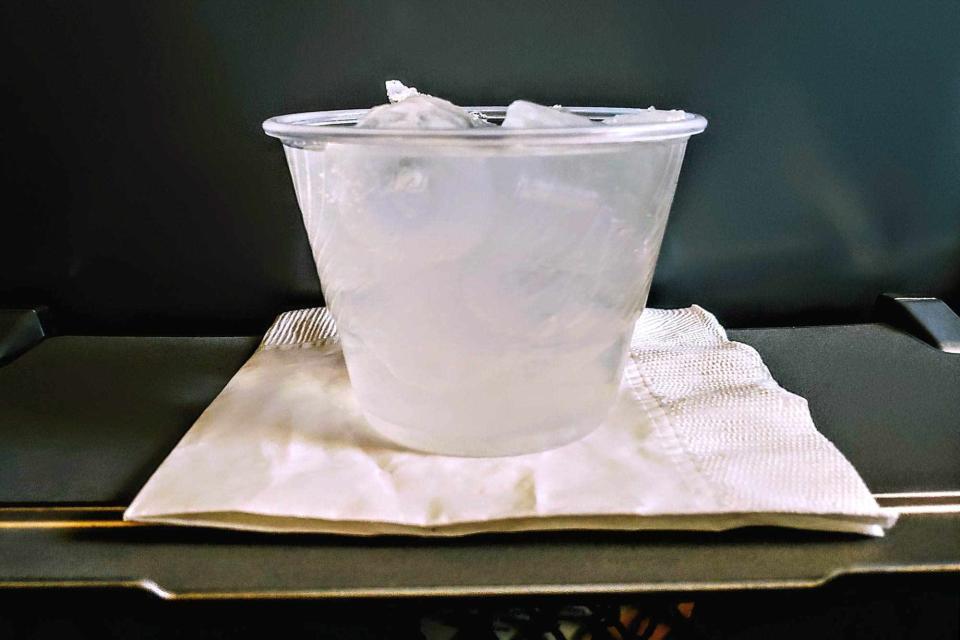You Should Think Twice Before Having Ice on a Plane
Sorry, but we're about to ruin ice for you forever.

Allison Cherry/Getty Images
You may be tempted to order a cocktail or a fizzy beverage the moment you sit down on your next flight. And that’s OK — there are plenty of great options available. However, there’s one part of your drink order you may want to think twice about while hurdling through the air at 30,000 feet: your ice.
While planes rarely have onboard ice machines, they do get their ice delivered from third-party services. And, according to a 2017 peer-reviewed study published in the Annals of Microbiology, ice is, quite bluntly, a little gross.
The researchers took samples from 60 ice cubes from both domestic and industrial facilities, which contained more than 50 different strains of bacteria. The researchers added, "A consistent percentage of the microorganisms identified from ice are known agents of human infections, and their presence indicates an environmental contamination.” That means, the cubes are likely picking up the grimy stuff somewhere along the way from the ice factory to your cup, which brings us to our next point — ice trays onboard planes are likely disgusting.
“Don’t get ice in your drink, don’t drink coffee, tea, or hot water on the plane, and don’t touch anything in the lavatory with your bare skin,” a Reddit user claiming to be a flight attendant commented on a viral thread from 2017. “The ice is put in a tray with a scoop, and the trays don’t get cleaned very often. Every surface on the plane is touched by hundreds of people daily and not often disinfected. We don’t have the opportunity to wash our hands at all during the beverage service.”
And if the Reddit user thought things were bad in 2017, they should get a load of 2023. “Some flight attendants get upset because it’s not clean,” Verna Montalvo, a cabin cleaner at Dallas-Fort Worth airport, shared with The Washington Post. “Of course, it’s not clean — because this is how much [time] they give us.”
According to Montalvo, both time constraints and labor shortages have contributed to a lack of airplane cleanliness. In fact, Montalvo stated her crew often has under five minutes to both clean and inspect planes. She’s even been tasked with cleaning an entire plane by herself. “We need time and more people,” Montalvo added.
And you should forget about the onboard water on planes too. A 2019 peer-reviewed study by the Hunter College NYC Food Policy Center at the City University of New York showed that the drinking water on 11 major and 12 regional airlines is possibly unsafe for human consumption.
For the study, the researchers gave each airline a "Water Health Score" based on 10 criteria, with 5 as the highest rating and 0 as the lowest. A score of 3 or better indicated an airline’s onboard water was “relatively” safe. As the findings showed, seven out of the 10 major airlines analyzed scored under a 3. Only Allegiant and Alaska (3.3 each) and Hawaiian Airlines (3.1) scored above the threshold.
“My takeaway from doing the research was to not drink the coffee and the tea. At all,” Charles Platkin, Ph.D., JD, MPH, and the executive director of the Hunter College NYC Food Policy Center, told Travel + Leisure. And, just as his team wrote in the findings, Platkin stated, “I don't wash my hands either. I have wipes that I use,” as they believe the water in the airplane bathrooms is too contaminated to do any good.
If, however, you simply cannot go without ice for a single flight there is one way around it — order a strong cocktail or at least a soda. As the ice researchers concluded, there is a “consistent reduction of bacterial risk due to alcohol, CO2, pH and antibacterial ingredients of vodka, whisky, Martini, peach tea, tonic water, and Coke.”
But to avoid any confusion, maybe just bring your own bottled beverage instead.
For more Travel & Leisure news, make sure to sign up for our newsletter!
Read the original article on Travel & Leisure.

